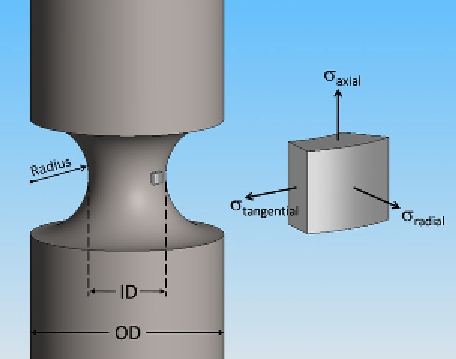Biomedical Engineering Reference
In-Depth Information
significantly longer than an unnotched (smooth)
specimen with the same cyclic notch stress evenly
distributed across the entire cross-section. Because
of this observation, researchers have suggested
that failure is dictated by the stresses in a volume
of material in the vicinity of the notch root and not
just at the root itself
[24,25]
. Therefore, one cannot
simply adjust estimates of fatigue life by using
k
t
alone (even if the loading is primarily elastic); it
is necessary to test notched specimens in fatigue
to assess how the material will respond in
the presence of a notch under cyclic loading
conditions.
Figure 5.4
A cylindrical bar with a circumferential
groove. The enlarged element shows the directions of
the principal stresses generated at the notch under
an applied tensile load. Courtesy of Ref.
[43]
.
5.3 PEEK Fracture Studies
5.3.1 Mechanical Properties
As mentioned earlier, the minimum-notched Izod
fracture toughness for implantable PEEK is 4 kJ/m
2
[20]
. According to the material property data sheets
for Victrex PEEK, an increase in molecular weight
results in an increase in impact strength/toughness
[26]
. An increase in crystallinity has been shown to
decrease Charpy impact toughness
[27]
. Increased
aging of the polymer has been shown to decrease
Charpy toughness
[27]
, though it should be noted that
PEEK is relatively difficult to age in vivo. An increase
in the radius of curvature of the notch,
r
r
, of the impact
specimen increases the Charpy impact toughness
[27]
(
Tabl e 5 .1
).
This leads to an elevation in the apparent yield strength
of the bulk specimen, known as notch strengthening
[16]
. In a material that is notch sensitive (notch
weakening), the material has little plastic flow capa-
bility; fracture in the vicinity of the notch is initiated,
and the specimen fails primarily in a grossly brittle
manner.
Interestingly, the fatigue behavior of a notched
specimen is not necessarily determined only by the
cyclic stress at the notch (which is higher than
that experienced by the rest of the specimen). In
many materials, a notched specimen will survive
Table 5.1
Summary of Material and Testing Effects on Impact Toughness, Fracture Toughness
(
K
IC
), and FCG Resistance of PEEK
Effect on
Impact Toughness
Material/Testing Parameter
K
IC
FCG
Molecular weight
[
[
[
[
Percent crystallinity
[
Y
Y
[
Spherulite size
[
Y
Y
Aging
[
Y
[ r
r
[
Loading rate
[
Y
50 to 150
C)
Temperature (
(
J
IC
)
[
[
























